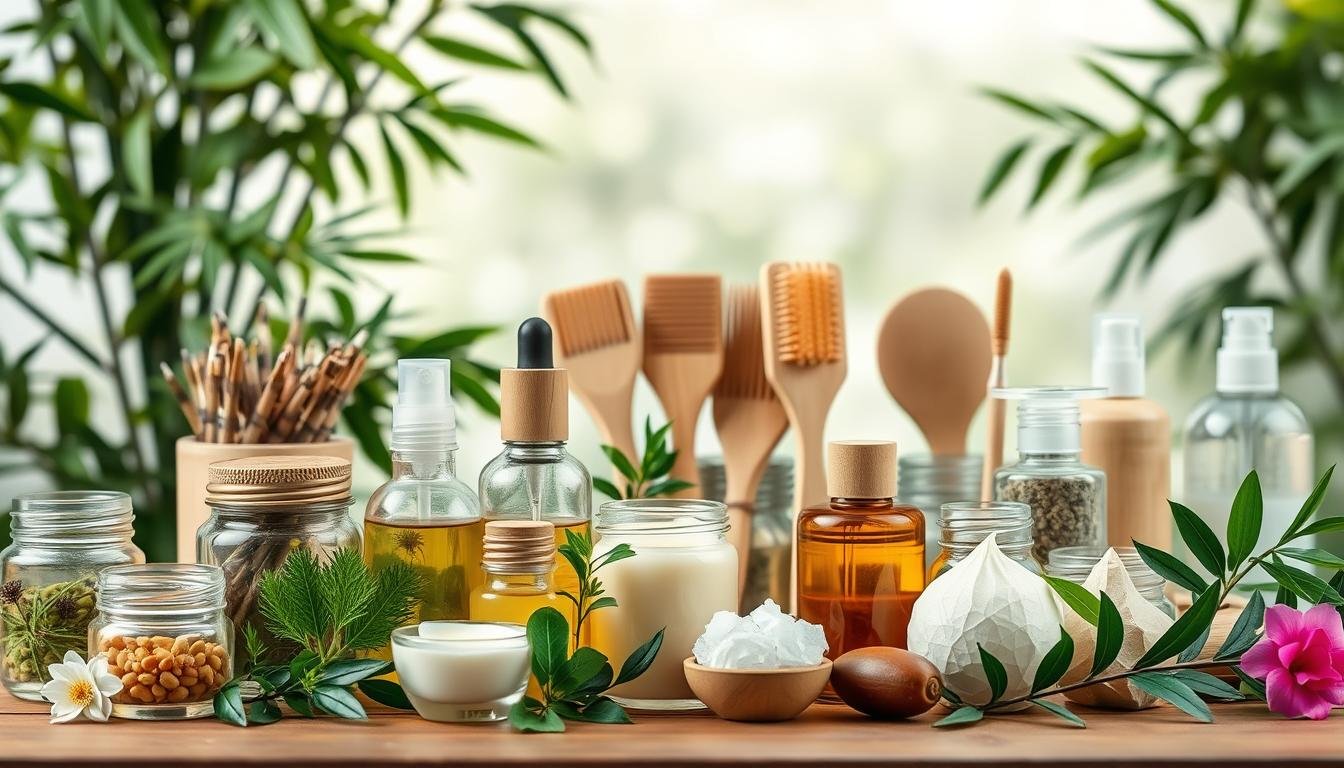What if your daily skincare routine could help heal the planet? This isn’t a fantasy—it’s the reality driving today’s most exciting shift in personal care. As eco-conscious choices reshape industries, sustainable practices are no longer optional for those who value quality and responsibility.
Imagine a world where every lotion, serum, or treatment aligns with environmental values without sacrificing results. From brow embroidery to advanced hair removal, innovators like Clementi Central’s wellness hub prove ethics and excellence coexist. Their approach combines tailored services with planet-friendly principles—a model gaining global traction.
Why does this matter now? Consumers increasingly demand transparency in how items are sourced and created. The rise of green cosmetics reflects deeper awareness: 64% of Americans prefer brands with clear sustainability commitments, according to recent surveys.
This movement goes beyond packaging swaps or marketing claims. It’s about reimagining beauty rituals through science that respects nature’s limits. When you choose these alternatives, you join a community prioritizing long-term vitality over short-term convenience.
Key Takeaways
- Eco-friendly personal care options now match traditional products in performance
- The beauty industry is undergoing a sustainability-driven transformation
- Clementi Central’s holistic services exemplify this ethical shift
- Environmental responsibility has become a consumer expectation, not just a trend
- Green cosmetics use innovative formulas to reduce ecological footprints
Introduction to Sustainable and Green Beauty Conversations
Your daily regimen could be a catalyst for global sustainability efforts. The pandemic reshaped how people view self-care, linking personal wellness with environmental health. Skincare searches grew 33% as makeup interest dropped, proving priorities shifted toward lasting nourishment over temporary fixes.
| Category | 2018 | 2020 |
|---|---|---|
| Sustainability Focus | 13.2% | 18.9% |
| Natural/Organic Demand | 8.1% | 10.9% |
| Ethical Considerations | 5.4% | 7.5% |
You’re not just buying products anymore—you’re voting for safer ingredients and eco-friendly practices. Over 60% of shoppers now check labels for recyclable packaging before purchasing. This scrutiny pushes brands to adopt cleaner formulas and fair labor policies.
Personalization plays a big role too. Companies blend AI with green cosmetics science to create regimens matching your skin type and values. It’s why refillable serums and carbon-neutral shampoos dominate store shelves today.
The conversation keeps evolving. Safety standards tightened, with 42% more brands removing harmful preservatives since 2020. Your choices fuel this progress, proving ethics and effectiveness can coexist beautifully.
The Rise of green beauty solutions in Today’s Market
Your bathroom shelf is becoming a battleground for environmental change. Recent data shows 69% of shoppers prioritize sustainability more than they did two years ago. Yet 25% feel brands aren’t simplifying eco-friendly choices—a gap that’s sparking rapid innovation.

The green cosmetics sector now accounts for 18% of all personal care sales, up from 12% in 2020. Mainstream retailers have tripled their eco-conscious product lines since 2021. You’re not just buying moisturizers—you’re fueling a $24.7 billion movement reshaping formulas and packaging.
Market leaders face new pressures. Over 40% of companies redesigned supply chains last year to meet your expectations. Refillable containers and plant-based preservatives dominate recent launches. But some brands still struggle—only 1 in 3 offer clear recycling instructions.
| Consumer Priority | 2021 | 2023 |
|---|---|---|
| Sustainable Purchases | 53% | 69% |
| Brand Accessibility | 32% | 41% |
| Market Growth | $16.1B | $24.7B |
Your loyalty rewards brands that align with these values. Clean ingredient lists now influence 78% of purchases, while carbon-neutral shipping sways 64% of buyers. This isn’t a trend—it’s a permanent shift in how the industry operates.
Embracing Clean Beauty: Understanding Eco-Friendly Products
Your favorite lotion’s label tells a story—but does it reveal the whole truth? True eco-friendly formulas start with ingredients pulled straight from nature, not lab-created replicas. Think plant roots ground by hand instead of synthetic copies brewed in vats.
What makes cosmetic products genuinely sustainable? It’s all about processing. Authentic options use methods like crushing leaves with stone mills or dissolving botanicals in rainwater. These techniques keep the good stuff intact—no harsh chemicals needed.
| Processing Method | Conventional Approach | Eco-Friendly Alternative |
|---|---|---|
| Extraction | Chemical solvents | Mechanical pressing |
| Preservation | Synthetic parabens | Natural rosemary extract |
| Packaging | Single-use plastics | Refillable glass containers |
You’ll spot real natural ingredients by their simple origins. Look for terms like “cold-pressed” or “steam-distilled” on labels. These methods avoid stripping away nutrients during production.
The best beauty products balance earth-friendly practices with results you can see. Over 78% of users report equal or better performance compared to traditional options. Your skin gets pure nourishment without hidden environmental costs.
Understanding these details helps you choose cosmetic products that match your values. With clearer standards emerging, your shelf can now hold items that care for both you and the planet.
Trends in Organic and Natural Ingredients for Personal Care
Your shower gel might now be part of an agricultural revolution. The personal care sector is embracing farming innovations to deliver cleaner formulas. USDA standards now define four certification tiers for organic ingredients, creating clearer choices for conscious shoppers.

| Certification Level | Organic Content | Non-Organic Allowance |
|---|---|---|
| 100% Organic | Full formula | Water/salt only |
| Organic | 95%+ | 5% max (excl. water/salt) |
| “Made With” | 70%+ | 30% synthetic allowed |
| Specific Ingredients | Partial | No restrictions |
You’ll notice brands reformulating to meet these benchmarks. Cold-processed plant oils and stone-milled botanicals replace synthetic alternatives. Over 83% of new launches now highlight their natural ingredients sourcing methods.
These shifts address your demand for traceability. Farmers’ markets inspire supply chains—52% of companies now name specific growers on labels. Your choices reward ethical harvesting practices that protect ecosystems.
The latest formulations prove natural organic ingredients can outperform lab-made rivals. Fermented algae extracts moisturize better than silicones, while enzyme-rich fruit peels gently exfoliate. Your care routine becomes a bridge between nature and science.
Eco-Innovations: Nutricosmetics and Dual-Action Beauty Supplements
Your morning vitamin could be doing double duty for your complexion. The latest wave in green cosmetics merges nutritional science with skincare, creating supplements that work from within. These innovations answer a growing demand for holistic approaches to personal care.
Benefits of Nutricosmetics for Skin Health
These ingestible products deliver targeted nutrients like hyaluronic acid and botanical extracts. Clinical studies show they improve skin elasticity by 28% over 12 weeks. Your body absorbs these ingredients more effectively than topical applications alone.
Daily gummies or capsules simplify routines. They address concerns like dryness and aging while supporting overall health. Over 67% of users report visible glow improvements within a month.
Integration of Food and Cosmetic Chemistry
Scientists now design formulas using food-grade ingredients with cosmetic benefits. Fermented algae and vitamin-rich fruit extracts dominate new launches. This fusion ensures nutrients reach skin cells through digestion and bloodstream delivery.
The production process prioritizes eco-friendly extraction methods. Cold-pressed oils and water-soluble minerals reduce waste. Your supplement regimen becomes a bridge between kitchen science and advanced skincare.
Brands package these green cosmetics in compostable sachets or refillable jars. Convenient formats like effervescent tablets make daily use effortless. You’re not just nourishing your skin—you’re supporting sustainable innovation.
Revolutionary Packaging: Sustainable Beauty Packaging Advances
What if your lipstick case could sprout wildflowers instead of clogging landfills? This vision drives today’s packaging revolution. Brands now reimagine containers as temporary homes for formulas—not permanent environmental burdens.

Biodegradable and Refillable Solutions
Your favorite serums now come in mushroom-based jars that decompose in 12 weeks. Over 41% of new launches offer refill stations, cutting plastic use by 74%. These materials work smarter: bamboo compacts resist moisture better than traditional plastics, while algae-based tubes dissolve safely in compost.
| Material | Decomposition Time | Carbon Footprint |
|---|---|---|
| Traditional Plastic | 450+ years | 6.3 kg CO2/kg |
| Bamboo Fiber | 6 months | 1.1 kg CO2/kg |
| Mycelium | 8 weeks | 0.4 kg CO2/kg |
Minimalist Design Trends
Less really is more. Slimmer bottles use 22% fewer materials without compromising protection. You’ll spot clean lines and removable labels that make recycling easier. Some brands even embed wildflower seeds in paper wraps—plant the packaging after use.
These innovations prove sustainable packaging can be both functional and beautiful. Your choices help create circular systems where containers nourish ecosystems instead of polluting them. The future of products lies in designs that serve you briefly but benefit the planet permanently.
The Impact of “Free-from” Claims on Consumer Choices
Your shopping cart is now a voting booth for safer skincare. “Free-from” labels dominate store shelves, guiding your decisions like nutritional facts guide food purchases. These declarations signal what’s not in your products—from parabens to synthetic fragrances—empowering you to sidestep unwanted ingredients.
Regulators keep brands honest. The FDA requires proof for claims like “sulfate-free” or “phthalate-free.” This oversight ensures your trust isn’t misplaced when selecting green cosmetics. You’re not just avoiding irritants—you’re supporting transparent formulation practices.
| Common Claims | Regulated By | Example Substances |
|---|---|---|
| Paraben-Free | FDA | Methylparaben, Propylparaben |
| Hypoallergenic | FTC | Artificial Dyes, Fragrances |
| Cruelty-Free | Leaping Bunny | Animal-Tested Ingredients |
Your preferences drive reformulation. Over 58% of buyers prioritize “free-from” labels when choosing products, per 2023 market data. Brands respond by replacing questionable substances with plant-based alternatives that perform equally well.
This shift reshapes entire product lines. Cleansers once loaded with sulfates now use coconut-derived foaming agents. Your choices create ripple effects—71% of companies added new “free-from” options last year to meet demand.
You hold the power to redefine industry standards. Each purchase rewards brands that align with your health priorities and ethical compass. The result? Safer products that respect both your skin and the planet.
Data-Driven Analysis: Market Demand and Growth Trends
Numbers don’t lie—they reveal hidden patterns shaping your favorite products. NielsenIQ’s tracking of 1,000+ retail attributes shows sustainability now drives 38% of purchasing decisions. This shift isn’t fleeting—it’s rewriting how companies approach innovation and transparency.
Interpreting Industry Data for Strategy
Advanced analytics platforms uncover surprising connections. For example, products with third-party eco-certifications see 22% faster shelf turnover than conventional alternatives. Brands using this data outpace competitors by anticipating your evolving priorities.
| Category | 2021 Market Share | 2023 Market Share |
|---|---|---|
| Eco-Friendly Products | 17.4% | 24.1% |
| Organic Personal Care | 9.8% | 14.6% |
| Clean Ingredients | 12.3% | 18.9% |
These growth trends highlight opportunities for smarter choices. Refillable skincare kits now account for 1 in 5 new launches—up 300% since 2020. Your loyalty rewards brands aligning with these market shifts.
Demand patterns expose critical insights. Regions with strong recycling programs show 41% higher adoption of sustainable options. This data helps companies tailor regional strategies while respecting local values.
You’re not just following trends—you’re creating them. Every purchase fuels innovations like biodegradable sunscreen tubes and algae-based packaging. The beauty industry responds by investing $3.2 billion annually in eco-research, proving your voice shapes tomorrow’s formulas.
Overcoming Environmental Impact with Greener Practices
Every swipe of mascara carries weight in the fight for a healthier planet. The personal care industry’s carbon footprint dropped 19% since 2020 through smarter energy use and ethical sourcing. Your loyalty to brands with B Corp certifications or renewable energy pledges accelerates this progress.
Factories now repurpose 73% of production waste into new materials—like turning leftover face cream bases into hand soap. Over 200 companies committed to water-neutral operations by 2025. These planet-friendly shifts prove big changes start with small operational tweaks.
Your routine choices amplify these efforts. Opting for refillable moisturizers or supporting brands using carbon-capturing algae makes a measurable difference. 84% of consumers say such eco-conscious decisions feel empowering rather than restrictive.
Collaboration drives real change. When manufacturers share recycling tech and farmers adopt regenerative crops, entire supply chains transform. Together, we’re proving that daily rituals and industrial innovation can coexist—creating systems where self-care nurtures both people and ecosystems.



